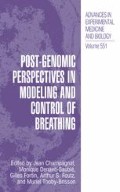Abstract
Brainstem respiratory neurons play a critical role in the generation of basic breathing rhythm in mammals (Richter et al., 2001, Feldman et al., 2003). This basic respiratory rhythm is modified by neurons probably with behaviour roles to support development of emotional expressivity. Such modulatory neurons are thought to be hierarchically organised throughout the neuraxis from the cerebral cortex through to the brainstem and spinal cord (Holstege, 1991a,b). One area within this hierarchy, that has been shown to be involved in motor patterning of defensive behaviour (in rats and cats) and vocalization (in cats) is the midbrain periaqueductal gray (PAG) (Carrive et al., 1987, Zhang et al., 1994).
Access this chapter
Tax calculation will be finalised at checkout
Purchases are for personal use only
Preview
Unable to display preview. Download preview PDF.
References
Richter, D. W., Spyer, K. M., 2001. Studying rhythmogenesis of breathing: comparison of in vivo and in vitro models. Trends in Neuroscience, 24, No. 8, 464–472.
Feldman, J. L., Mitchell, G. S., Nattie, E. S., 2003. Breathing: Rhythmicity, Plasticity, Chemosensitivity. Annu. Rev. Neurosci. 26, 239–266.
Holstege, G., 1991a. Descending motor pathways and the spinal motor system. Limbic and non-limbic components. In Progress in Brain Research. Edited by G. Holstege Amsterdam: Elsevier Vol 87. p 307–421.
Holstege, G., 1991b. Descending pathways from the periaqueductal gray and adjacent areas. In The Midbrain Periaqueductal Gray Matter: Functional Anatomical and Immunohistochemical Organization. Edited by A. Depaulis and R. Bandler. New York Plenum Press, p 239–265.
Carrive, P., Dampney, R. A. L., Bandler, R., 1987. Excitation of neurons in a restricted region of the periaqueductal gray elicits both behavioural and cardiovascular components of defence reaction in unanaesthetised decerebrate cat. Neurosci. Lett, 81, 273–278.
Zhang, S. P., Davis, P. J., Bandler, R., Carrive, P., 1994. Brainstem Integration of Vocalization: Role of the Midbrain Periaqueductal Gray. Journal of Neurophysiology, 72, 1337–56.
Li, Z.Y., Xia, B.L., Huang, C.J., 1992. Effects of microinjection of L-glutamate into locus coeruleus complex area on respiration. J. Tongji Medical University 12, 205–208.
Champagnat, J., Denavit-Saubie, M., Henry, J., Leviel, V., 1979. Catecholaminergic depressant effects on bulbar respiratory mechanisms. Brain Res. 480, 57–68.
Feldman, P.D., Felder, R.B., 1989. Alpha 2-adrenergic modulation of synaptic excitability in the rat nucleus tractus solitarius. Brain Res. 480, 190–197.
Depaulis, A., Keay., K. A., Bandler, R. 1992. Longitudinal neuronal organization of defensive reactions in the midbrain periaqueductal gray region of the rat. Exp. Brain. Res. 90, 307–318.
Feldman, J. L., Speck, D. F., 1983. Interactions among inspiratory neurons in dorsal and ventral respiratory groups in the cat medulla. J. Neurophysiol. 49: 472–490.
Huang, Z. G., Subramanian, S. H., Balnave, R. J., Turman, A. B., Chow, C. M., 2000. Roles of periaqueductal gray and nucleus tractus solitarius in cardiorespiratory function in the rat brainstem. Respiration Physiology, 120, 185–195.
Author information
Authors and Affiliations
Editor information
Editors and Affiliations
Rights and permissions
Copyright information
© 2004 Kluwer Academic/Plenum Publishers, New York
About this paper
Cite this paper
Subramanian, H.H., Balnave, R.J., Chow, C.M. (2004). Behavioural Control of Breathing in Mammals: Role of the Midbrain Periaqueductal Gray. In: Champagnat, J., Denavit-Saubié, M., Fortin, G., Foutz, A.S., Thoby-Brisson, M. (eds) Post-Genomic Perspectives in Modeling and Control of Breathing. Advances in Experimental Medicine and Biology, vol 551. Springer, Boston, MA. https://doi.org/10.1007/0-387-27023-X_21
Download citation
DOI: https://doi.org/10.1007/0-387-27023-X_21
Publisher Name: Springer, Boston, MA
Print ISBN: 978-0-306-48507-7
Online ISBN: 978-0-387-27023-4
eBook Packages: Biomedical and Life SciencesBiomedical and Life Sciences (R0)

